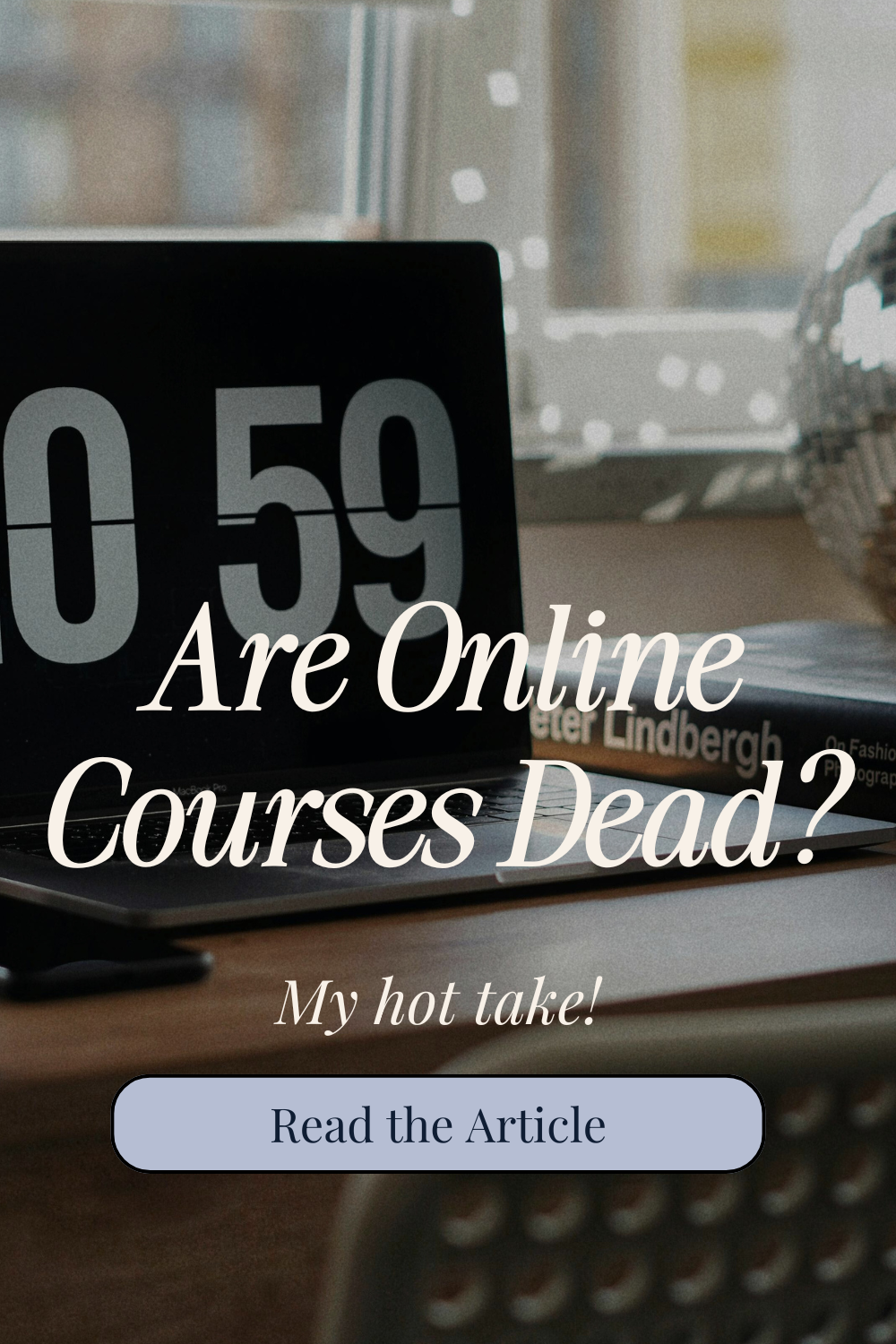Are Online Courses Officially Dead? Here’s my hot take.
NO, but I do believe the online course content that people are craving is definitely changing. Let me explain what I'm noticing in the industry...
First off—I still consider myself an online course coach (I really love all digital products and still can’t shut-up about how great they are). But I’ve been studying online course creation since 2016, so I feel I have some insights on this question.
I DON’T think they are dead... at all. But the industry has changed since 2020 FOR SURE. And I think that’s what people are noticing and why people are saying the industry is dead or “oversaturated.”
For example, I do think the way people learn has changed and our attention spans have changed since 2020.
Is it burnout?
Is it access to too much information?
Is it too much doom-scrolling?
Is it too much copying from one another?
Is it overpromised results just to make a quick buck?
I dunno... but I feel it myself. Sometimes I’m over the “passive income” and “online course,” craze but I think that’s just because I’m entrenched in the industry and it feels like everyone is just trying to make a quick buck. I miss the days of people making courses to actually help people.
BUT that doesn’t mean online courses are dead.
So Here’s What I’m Noticing Personally (Just My Hot Take!)
People’s Attention Spans Are Shorter
I’ve noticed that even a 20-30 minute course video is too long now. I get comments that my modules are too long when a few years ago I never got that comment.
My advice:
Break your course content up into shorter chunks so it feels achievable (5-15 minutes)
Edit your content down to take out the fluff, the ums, ahhs, and pauses. Get right to the point.
Use multiple forms of content (written, audio, and video) so people can skim or comprehend quicker
Break your course into levels (basic, intermediate, advanced) so it’s a natural progression through the materials. This also allows people to have access to lower cost content if you allow them to just purchase one then upgrade when they are ready. It feels more achievable.
Audio-Only Courses Are on the Rise
People are busy! Audio content allows them to take their course with them wherever they go. You want your students to finish your course. Audio-only courses can help them achieve that.
Think about it: Your ambitious student is juggling client calls, family commitments, and their own wellness routine. They’re passionate about learning, but finding an hour to sit down uninterrupted and watch videos? That’s a luxury they may not have.
The solution is surprisingly simple: meet your students where they are. By offering your course content in multiple formats—especially audio versions of your lessons—you’re not just being accommodating, you’re revolutionizing how your students learn. Plus, many people learn in different ways. By providing multiple formats, they can choose what works best for them.
To provide audio lessons as well as video lessons in your course (something I’m doing for 2025) you can use an MP4 to MP3 converter OR use a service like HelloAudio (affiliate link) to add a private course podcast so your students can listen on the go! (Now that’s pretty cool.)
Another fresh idea for 2025 / 2026 is doing the audio only course or audio only summit (with no video at all!) You could even invite guest experts into your summit and host it on a platform like Hello Audio. If you’re struggling with the tech side of a traditional online course or don’t want an overwhelming course platform, an audio summit or an audio course could be a great alternative for you!
People Are Wary to Invest in a Big Expensive Course Without Knowing the Person
Gone are the days of someone impulse-buying a $1,500 course without knowing what’s inside. I also think people in the online course space have been getting a little out of hand saying “charge as much as you can!! Charge your worth! Raise your prices! People will pay!” Right now, people are hurting financially and I do think as a course creator you need to take that into account and offer flexible payment options and lower cost educational alternatives.
To counteract this fear: Give your audience smaller content to consume (free and low-cost) so they get to know you first. Overdeliver so they trust you’re one of the good course creators out there. Start with a smaller mini course first to test your concept (this is actually my advice to everyone, anyway!) Don’t bite off more than you can chew and totally get sidetracked on your course’s mission.
People Are Craving Community
Maybe it’s the rise of AI. Maybe it’s the lack of connection since 2020. I dunno... but things have changed.
To counteract this: Give them a place to ask questions, share their frustrations, get accountability, and feel connected to you and others. Now THAT is something that people will pay for.
My Personal Observations
I’ve personally noticed my own online course consumption is down (but my buying of smaller micro-courses or specific micro-content is up), and I’d be willing to buy a large signature course if I already invested in something smaller from a creator. (I’ve almost invested in web design courses and probably will at some point, just haven’t pulled the trigger.)
People Are Paying for Done-For-You Services
They feel overwhelmed, and if you can help them solve a problem (whether in a course or not), they will pay.
The Best Course Creators Right Now Are Reallyyyyyyy Peeling Back the Curtain
They aren’t holding back on the good stuff. They are giving the juicy details people really want. No fluff and no BS anymore. It’s just not acceptable.
Along those lines—people aren’t wanting the fluffy webinar anymore. They want real insights, strategies, and methods that will get them from point A to point B. If you’re giving a free webinar that doesn’t really talk about much... you need to do better. (Tough love!)
People Are Tired of Empty Promises
People are tired of “overnight success” promises, reused content from former Zoom calls, dusty modules from 2020, and the endless cycle of launch-and-abandon courses.
But they may not be tired of YOUR COURSE IDEA. That’s the difference.
People No Longer Want More, More, More Content
Previously, I believed people wanted long courses with as much content and bonus content as they could get their hands on. It felt FUN to get all those bonuses and extra video content back in the day. I used to buy courses just for the fun bonuses!
Now... people just want quick.
I do believe personally that people no longer crave perfectly polished “gurus” who seem to have it all figured out. I do think people want authentic course creators who share their journey in real-time and may also be struggling with the same things in the course.
So No, I Definitely Don’t Think Courses Are Dead (and I’m not just saying that).
I think parts of courses are dead.
The PDF freebie that leads to a $3,000 course is dead.
The fluffy webinar that doesn’t give the viewer anything but a sales pitch is dead.
And it’s true. The online course industry is CHANGING.
And I think that’s okay. And as an online course coach, I have to keep up with the trends and be honest with you about where I think it’s heading.
I still think it’s 100% worthwhile to create an online course (especially if you need more freedom and flexibility in your health and wellness business) & if you’re struggling with that process I have lots of resources for you to help you get launched.
What are you noticing in your own course consumption or creation? Hit those comments and let me know—I’m curious if you’re seeing the same shifts in your own course consumption or if you’re noticing other trends.
Can’t wait to connect with youuuu.
Pin this image to Pinterest to save this blog post!



